GAO Report: DoD’s Satellite Control Network Needs an Update to its Life Cycle Sustainment Plan

A radar antenna receives data from satellites at Kaena Point Space Force Station, Hawaii. Photo: U.S. Space Force, Senior Airman Brooke Wise
The U.S. Space Force intends to bolster its satellite communications capacity through the use of electronically-steered phased array antennas for the DoD Satellite Control Network (SCN), and a new Government Accountability Office (GAO) study urges the Department of the Air Force to finish its planned update to the SCN life cycle sustainment plan (LCSP).
“SCN is a critical part of Space Force’s control system for space assets, but it is facing obsolescence challenges and potential capacity gaps as DoD and other agencies launch more satellite systems that will rely on the network,” GAO said in the report, Satellite Control Network: Updating Sustainment Plan Would Help Space Force Better Manage Future Efforts (GAO-23-105505).
“The LCSP is a critical tool for planning and administering the sustainment of the SCN but the current LCSP, issued in 2017, has not been updated in accordance with DoD instruction,” GAO said. “As a result, the LCSP does not contain updated information about SCN modernization programs and organizational changes within Space Force. Therefore, it no longer provides a viable plan for sustainment of the SCN.”
In May last year, the Space Force Space Rapid Capabilities Office in Albuquerque, N.M., said that it had awarded BlueHalo a $1.4 billion contract for the Satellite Communications Augmentation Resource (SCAR) program to increase communications capacity 10 -fold for satellites in Geosynchronous Orbit (GEO) “through transportable, electronically steerable phased array antennas … as the demands on the SCN rapidly grow in the coming years.”
“Space Force officials expect the cost projected to operate SCAR will be significantly less than the current SCN antennas, with an estimated per-minute rate of $1.60 compared the current SCN cost of $8.75 per minute, according to the estimates provided by SpOC [Space Force’s Space Operations Command],” the new GAO report said.
Initiated in 1958 to support the National Reconnaissance Office’s CORONA imagery satellites, SCN is a global system with 19 antennas to help provide command, control, and communications for DoD satellites. SCN supports telemetry, tracking of space objects, and command for U.S. defense satellites and space programs run by NASA and foreign allies. A number of contractors, including KBR, Honeywell, L3Harris, Lockheed Martin, and CACI International have worked on SCN, which has relied on parabolic antennas.
Of SCN’s 19 antennas, three are located at Vandenberg Tracking Station at Vandenberg Space Force Station, California; two at Kaena Point Space Force Station, Hawaii; three each at Diego Garcia Station on Diego Garcia and Guam Tracking Station at Andersen AFB, Guam; three at the Telemetry and Command Squadron in Oakhanger, England; three at the New Hampshire Tracking Station at New Boston Space Force Station in New Hampshire; and two at the Thule Tracking Station at Pituffik Space Base, Greenland, formerly known as Thule Air Base–DoD’s northernmost installation.
GAO said that SCN utilization has averaged 75% over the last decade and that insufficient SCN capacity could impinge on future Space Force and National Reconnaissance Office missions, as Space Force told GAO that the commercial standard for utilization is 70% or lower.
Space Force officials told GAO “that it is not just the increase in launches that is increasing SCN utilization but also the increase in the number of satellites per launch,” per the GAO report. “The officials stated that each satellite launch can now include 20 or more satellites at a time that will rely on SCN for regular contact whereas in the past launches would typically include a single satellite. This increase in satellites reliant on SCN will further limit available SCN capacity. SCN operators said that without additional technology that allows more than one contact per antenna, they would need an additional 16 parabolic antennas, for a total of 35 antennas, to keep up with future demands.”
This story was first published by Via Satellite sister outlet Defense Daily.